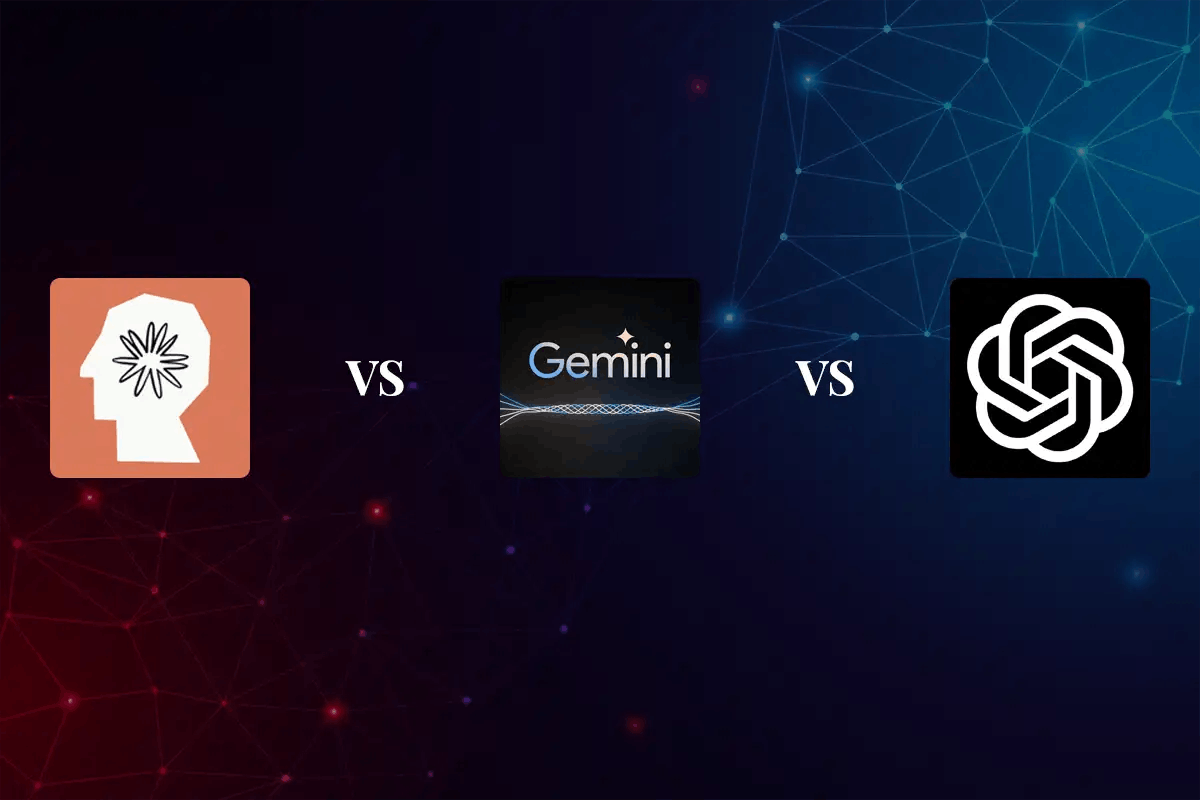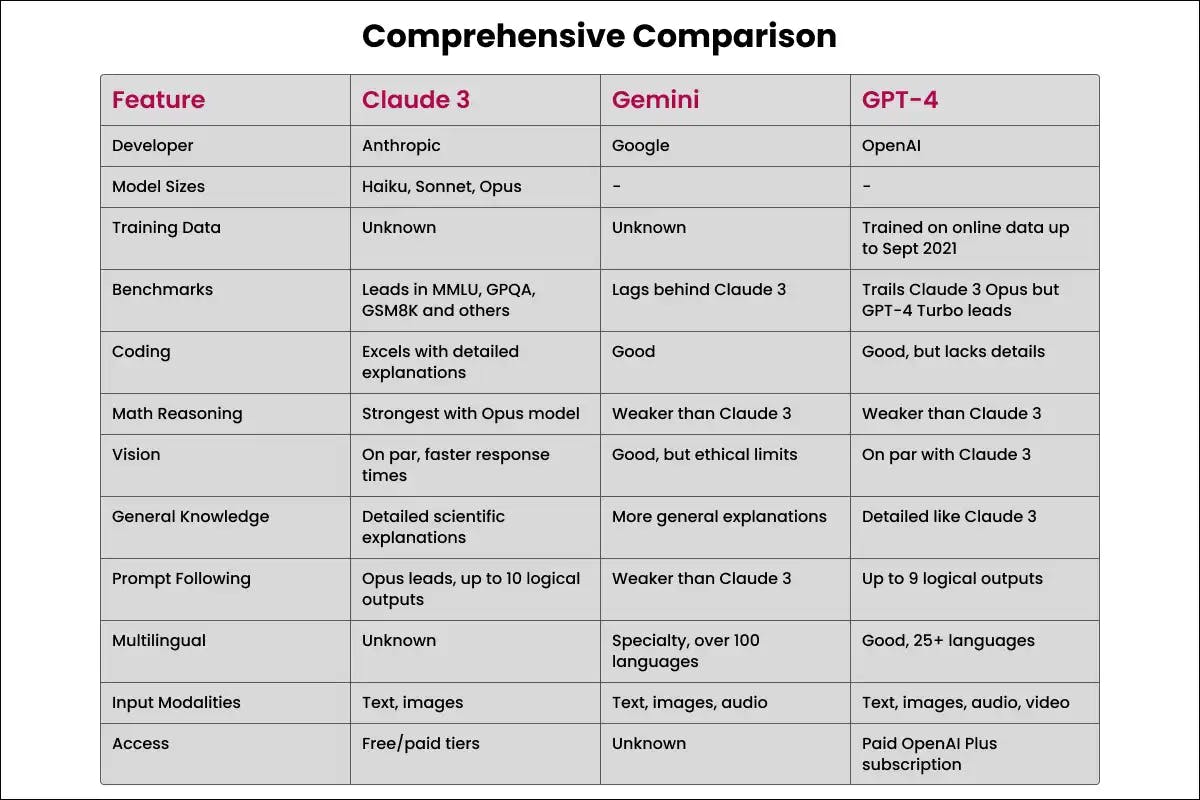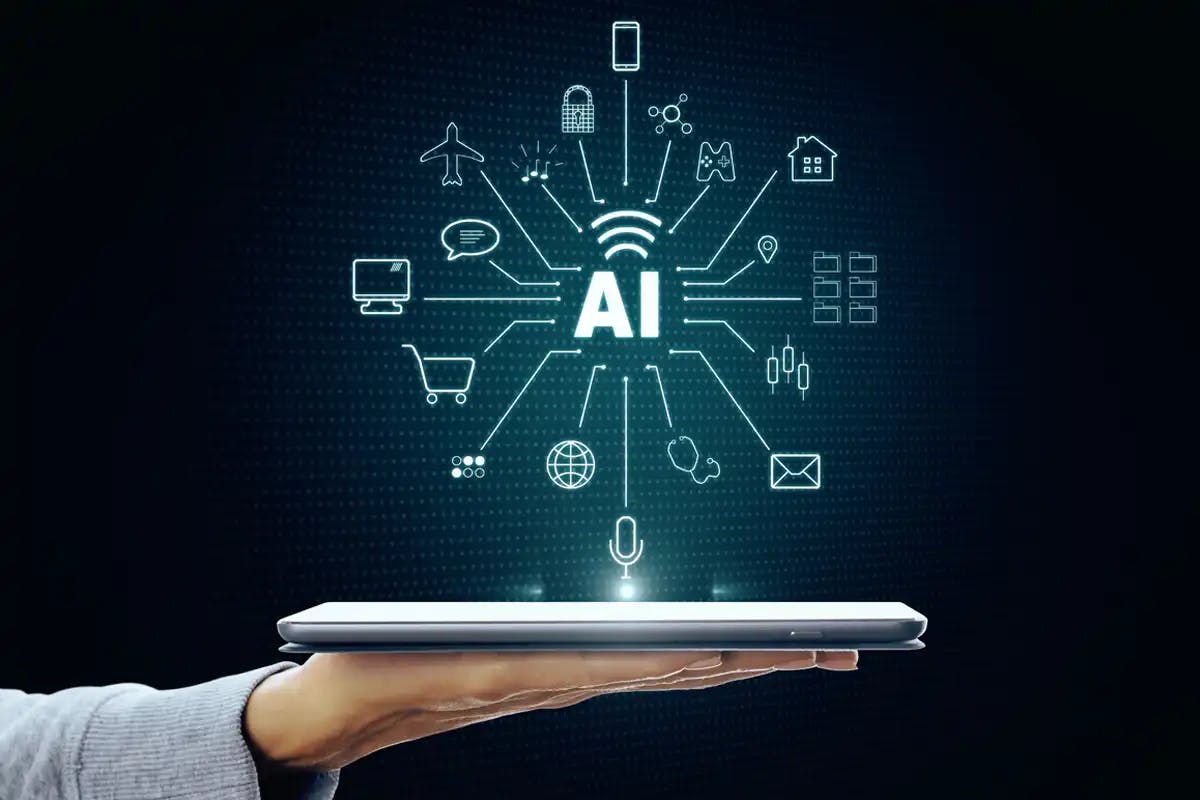


Artificial intelligence (AI) has been rapidly growing in recent times. Many big tech companies and new businesses are working hard to make the best language models. Three of the leading models are Claude 3 by Anthropic, Gemini by Google, and GPT-4 by OpenAI. Each of these AI models has special abilities and strengths that make them stand out. Comparing them to see which one is better has become a hot topic among developers, researchers, and people interested in AI.
According to Anthropic, their latest offering, Claude 3, outperforms both Gemini and GPT-4 across a wide range of benchmarks. These assessments examine different areas of AI capabilities, including undergraduate-level expert knowledge (MMLU), graduate-level expert reasoning (GPQA), basic mathematics (GSM8K), and more.
Anthropic's assertions are supported by their internal evaluations. These assessments demonstrate that the Claude 3 Opus model outperforms GPT-4 in nearly every benchmark area. The Opus model has gained significant recognition for its superior performance in tasks requiring advanced reasoning abilities, language comprehension, and adherence to prompts.
In tests conducted to evaluate coding and evaluation performance, Claude 3 demonstrated a clear edge over its competitors. When tasked with generating code for a sorting algorithm, such as selection sort, Claude 3 not only provided the correct code snippet but also offered a detailed explanation and sample output, showcasing its superior ability to reason and communicate its understanding.
In contrast, while both Gemini and GPT-4 generated accurate code, they fell short in providing comprehensive explanations and sample outputs, highlighting Claude 3's strength in this domain.
One area where Claude 3 truly shines is mathematical reasoning. The Sonnet model of Claude 3 expertly tackled an intricate math problem, offering a flawless answer along with a thorough breakdown for clarity. Remarkably, both Gemini and GPT-4 struggled with the same problem, exhibiting logical inconsistencies or failing to reach the correct answer.
Claude 3 showcases exceptional capabilities in tackling intricate mathematical reasoning challenges. Its adeptness at handling complex computations and quantitative analysis renders it a compelling choice for developers and researchers working in fields involving such intricate mathematical operations.
In the world of vision capabilities, all three models demonstrated impressive performance when tasked with identifying objects or scenes from images. However, when presented with images containing famous personas, Gemini refused to respond, possibly due to ethical considerations or policies enforced by Google.
While Claude 3 and GPT-4 successfully identified the movie depicted in such images, Gemini's refusal to engage with certain types of content highlights the trade-offs and considerations that developers must weigh when choosing a model for their specific use case.
When evaluating general and common knowledge, all three models provided correct explanations for a simple question about the sun rising in the east. However, the true differences emerged in the reasoning and logical conclusions derived from the answers. The response from the Gemini AI model was more general, focusing on referential elements, while Claude 3 and GPT-4 went into deeper scientific details. They used technical terminology, showing a more nuanced grasp of the underlying principles.
This indicates that although all three AI models have solid knowledge, Claude 3 and GPT-4 offer more in-depth, scientifically-grounded comprehension. This makes them better suited for applications needing advanced technical expertise or specialised domain knowledge.
Here is the comprehensive comparison table featuring 3 platforms:

Declaring an outright winner in the battle between Claude 3, Gemini, and GPT-4 is a complex work, as each model excels in different areas and caters to diverse use cases. However, based on the evaluations and comparisons presented in the provided documents, Claude 3 emerges as a strong contender, taking the lead in coding evaluation, mathematical reasoning, and certain aspects of vision capabilities.
Anthropic's claims of Claude 3's superior performance across various benchmarks seem to hold, particularly in the case of the Opus and Sonnet models. Distinct models demonstrate advanced capabilities in reasoning, interpreting questions accurately, and recognizing characters from images. These skills make them suitable for tasks requiring high precision and contextual comprehension.
However, each model has unique strengths and weaknesses. Claude 3rd May perform better on certain benchmarks, while GPT-4 excels in conversation, flexibility, and adapting to diverse text-based tasks. Gemini, alternatively, shines in visual processing and multilingual communication, proving valuable for cross-cultural applications or image analysis.
The decision on employing a particular model hinges upon the precise demands of the task, the developer's inclinations, and the compromises they make regarding efficiency, ethical facets, and computational resources. Determining the optimal model necessitates a judicious evaluation of these factors.
As the field of artificial intelligence continues to evolve at a breakneck pace, it becomes increasingly evident that no single model can reign supreme indefinitely.
Developers and researchers may find themselves using the unique capabilities of multiple models in tandem, combining the strengths of Claude 3 for complex reasoning tasks, Gemini for multilingual applications, and GPT-4 for its conversational prowess and adaptability.
As AI technologies keep improving, we can look forward to more focus on tailoring these models to different needs. Companies and developers will be able to adjust and customise the models with specialised knowledge for their uses. This flexibility will let them tap into even greater possibilities and drive breakthroughs across many fields and industries. We may see models customised for healthcare to aid medical research and diagnosis. Models could be tuned for finance, enhancing analysis and forecasting capabilities. The ability to mould advanced AI for various domains opens up exciting opportunities.
Artificial intelligence (AI) is a rapidly growing field that continues bringing innovation through this technology. The development of advanced AI models like Claude 3, Gemini, and GPT-4 has sparked a fierce competition among tech giants and researchers to create the most powerful and capable AI system. However, this competition is not just about proving superiority; it also highlights the immense possibility for collaboration and synergy among these models. Each of these AI models brings its unique strengths and capabilities to the table. Combining the strengths of each model, researchers and developers can create more powerful and versatile AI systems that can tackle complex challenges across various domains. The coexistence of these AI models is not merely about competition; it also presents opportunities for collaborative development and knowledge sharing.




Every great partnership begins with a conversation. Whether you’re exploring possibilities or ready to scale, our team of specialists will help you navigate the journey.